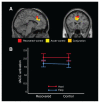Intact value-based decision-making during intertemporal choice in women with remitted anorexia nervosa? An fMRI study
- PMID: 31595737
- PMCID: PMC7828910
- DOI: 10.1503/jpn.180252
Intact value-based decision-making during intertemporal choice in women with remitted anorexia nervosa? An fMRI study
Abstract
Background: Extreme restrictive food choice in anorexia nervosa is thought to reflect excessive self-control and/or abnormal reward sensitivity. Studies using intertemporal choice paradigms have suggested an increased capacity to delay reward in anorexia nervosa, and this may explain an unusual ability to resist immediate temptation and override hunger in the long-term pursuit of thinness. It remains unclear, however, whether altered delay discounting in anorexia nervosa constitutes a state effect of acute illness or a trait marker observable after recovery.
Methods: We repeated the analysis from our previous fMRI investigation of intertemporal choice in acutely underweight patients with anorexia nervosa in a sample of weight-recovered women with anorexia nervosa (n = 36) and age-matched healthy controls (n = 36) who participated in the same study protocol. Follow-up analyses explored functional connectivity separately in both the weight-recovered/healthy controls sample and the acute/healthy controls sample.
Results: In contrast to our previous findings in acutely underweight patients with anorexia nervosa, we found no differences between weight-recovered patients with anorexia nervosa and healthy controls at either behavioural or neural levels. New analysis of data from the acute/healthy controls sample sample revealed increased coupling between dorsal anterior cingulate cortex and posterior brain regions as a function of decision difficulty, supporting the hypothesis of altered neural efficiency in the underweight state.
Limitations: This was a cross-sectional study, and the results may be task-specific.
Conclusion: Although our results underlined previous demonstrations of divergent temporal reward discounting in acutely underweight patients with anorexia nervosa, we found no evidence of alteration in patients with weight-recovered anorexia nervosa. Together, these findings suggest that impaired valuebased decision-making may not constitute a defining trait variable or “scar” of the disorder.
© 2020 Joule Inc. or its licensors
Conflict of interest statement
V. Roessner has received payment for consulting and writing activities, independent of the current work, from Lilly, Novartis and Shire Pharmaceuticals; lecture honoraria from Lilly, Novartis, Shire Pharmaceuticals and Medice Pharma; and support for research from Shire and Novartis. He has carried out (and is currently carrying out) clinical trials in cooperation with the Novartis, Shire and Otsuka. J. King, F. Bernardoni, D. Geisler, F. Ritschel, A. Doose, S. Pauligk, K. Pásztor, K. Weidner, M. Smolka and S. Ehrlich declare no competing interests.
Figures




Similar articles
-
Metabolic state and value-based decision-making in acute and recovered female patients with anorexia nervosa.J Psychiatry Neurosci. 2020 Jul 1;45(4):253-261. doi: 10.1503/jpn.190031. J Psychiatry Neurosci. 2020. PMID: 32129584 Free PMC article.
-
Altered Neural Efficiency of Decision Making During Temporal Reward Discounting in Anorexia Nervosa.J Am Acad Child Adolesc Psychiatry. 2016 Nov;55(11):972-979. doi: 10.1016/j.jaac.2016.08.005. Epub 2016 Sep 5. J Am Acad Child Adolesc Psychiatry. 2016. PMID: 27806865
-
Partially restored resting-state functional connectivity in women recovered from anorexia nervosa.J Psychiatry Neurosci. 2016 Oct;41(6):377-385. doi: 10.1503/jpn.150259. J Psychiatry Neurosci. 2016. PMID: 27045551 Free PMC article.
-
Reward contamination in restrictive anorexia nervosa: A meta-analysis of functional MRI studies.Pharmacol Biochem Behav. 2025 Jul;252:174031. doi: 10.1016/j.pbb.2025.174031. Epub 2025 May 8. Pharmacol Biochem Behav. 2025. PMID: 40348135 Review.
-
The role of body image and self-perception in anorexia nervosa: the neuroimaging perspective.J Neuropsychol. 2018 Mar;12(1):41-52. doi: 10.1111/jnp.12106. Epub 2016 May 25. J Neuropsychol. 2018. PMID: 27220759 Review.
Cited by
-
Deliberating trade-offs with the future.Nat Hum Behav. 2020 Mar;4(3):238-247. doi: 10.1038/s41562-020-0834-9. Epub 2020 Mar 17. Nat Hum Behav. 2020. PMID: 32184495 Free PMC article. Review.
-
Willing to wait: Anorexia nervosa symptomatology is associated with higher future orientation and reduced intertemporal discounting.Sci Rep. 2025 Feb 6;15(1):4508. doi: 10.1038/s41598-024-80597-7. Sci Rep. 2025. PMID: 39915511 Free PMC article.
-
Waiting for it: Anorexia Risk, Future Orientation, and Intertemporal Discounting.Res Sq [Preprint]. 2024 Mar 27:rs.3.rs-4002723. doi: 10.21203/rs.3.rs-4002723/v1. Res Sq. 2024. Update in: Sci Rep. 2025 Feb 06;15(1):4508. doi: 10.1038/s41598-024-80597-7. PMID: 38585785 Free PMC article. Updated. Preprint.
-
Strengthened Default Mode Network Activation During Delay Discounting in Adolescents with Anorexia Nervosa After Partial Weight Restoration: A Longitudinal fMRI Study.J Clin Med. 2020 Mar 25;9(4):900. doi: 10.3390/jcm9040900. J Clin Med. 2020. PMID: 32218141 Free PMC article.
-
Computational Perspectives on Cognition in Anorexia Nervosa: A Systematic Review.Comput Psychiatr. 2025 Apr 7;9(1):100-121. doi: 10.5334/cpsy.128. eCollection 2025. Comput Psychiatr. 2025. PMID: 40224147 Free PMC article. Review.
References
-
- O’Hara CB, Campbell IC, Schmidt U. A reward-centred model of anorexia nervosa: a focussed narrative review of the neurological and psychophysiological literature. Neurosci Biobehav Rev. 2015;52:131–52. - PubMed
Publication types
MeSH terms
LinkOut - more resources
Full Text Sources
Medical
